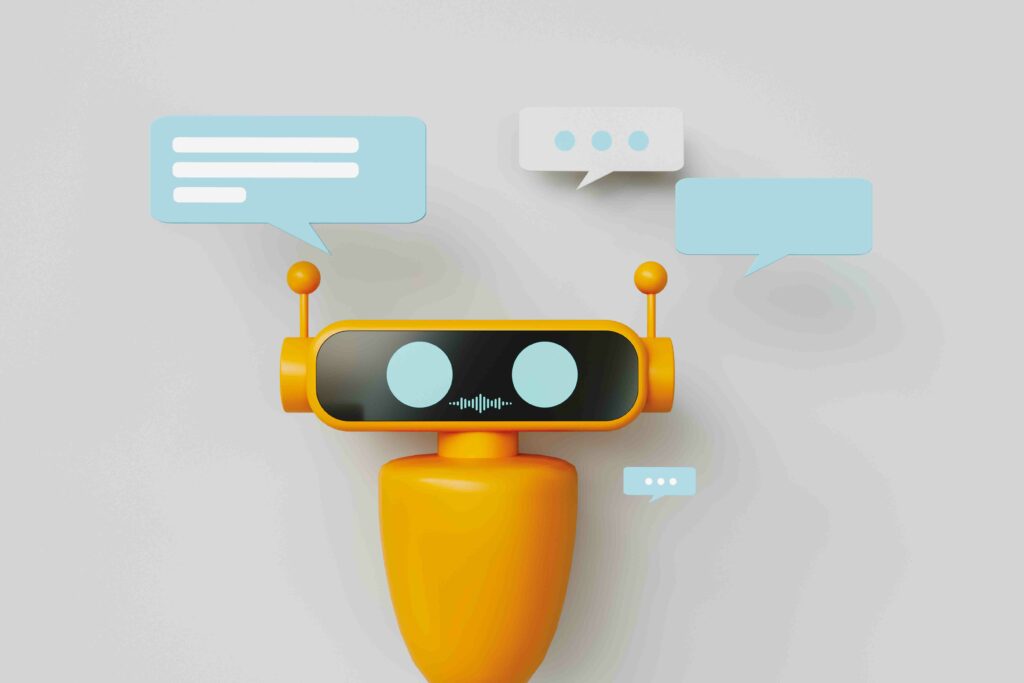Trends
The new large language models have gained great attention around the world. But they have not been interpreted the same way everywhere. Partly because they have not been trained with the same care in all languages and cultures. Imminent’s question of the year explores how this technology has been experienced in different countries. And below are accounts from Nigeria, Uruguay, Japan and Portugal.
NIGERIA
Adebola Rayo

Photo Credit: Deepmind – Unsplash
The Relationship Between AI and Nigerians: A Slow Burn or a Revolution
Many Nigerians began using AI through viral trends like experimenting with image generators to predict one’s future looks. Despite the worries about providing images and personal information that could be used as training data, those trends have resurfaced every few months over the recent past.
With the world’s attention on AI, there has been an uptick in Nigerian startups deploying AI solutions across sectors from justice to health and from banking to labour. Unsurprising, since Nigeria’s Minister of Communications, Innovation and Tech, Bosun Tijani, has grand plans to make Nigeria a global leader in AI. In and beyond business, the relationship between Nigerians and AI is still in the early days. So far, though, that relationship seems to me to be one of exploration and fun.
Around the time the use of OpenAI’s ChatGPT was growing exponentially across the world in late 2022 and early 2023, Nigerian Justin Irabor was training Kainene Vos Savant (a.k.a. GalaxyBrainBot) to be his StudyBuddy. Due to interest from others as he shared his journey online, he retrained the Chatbot for general usage and opened it up to the public on Telegram in March 2023. Powered by OpenAI’s GPT model, he trained Kainene Vos Savant to be more “accessible to laypeople”. With its relatable tone and better understanding of local context, it quickly gained thousands of users as a Nigerian alternative to ChatGPT. Its use cases are listed as StudyBuddy, Research Assistant, Dissing your Opps, and Pidgin Fun, among others.
Now, let’s talk about entertainment. In October 2023, Amadou Elizabeth Aminata (self-titled JaDroLita or Jarvis AI) began posting skits of herself as a humanoid in Nigerian contexts. Jadrolita’s mannerisms, movements, and voice soon earned her the moniker, ‘Nigerian AI’. Today, the human mimicking machines mimicking how humans act has seen her followers grow to 969k on Instagram and 1.1m on TikTok in less than six months. While JaDroLita doesn’t use AI in making her content, her popularity and moniker reflect what Nigerians think of her depiction of humanoids. Interestingly, AI’s integration into daily life and entertainment in Nigeria is also sparking a resurgence in the folktales that once were household staples but haven’t had much visibility in print or audio-visual storytelling in the last few decades. Through generative AI video platforms like ChatGPT and MidJourney, a few content creators are creating folktale videos that amass tens of thousands of views across YouTube and other social media platforms. Sora, a more advanced text-to-video application, is expected to accelerate this even further.
In a country of about 400 languages, of which only three are currently available via Google Translate, perhaps AI will impact culture and language in exponential ways.
It’s not just individual content creators using AI, though. During the African Cup of Nations tournament in January and February 2024, Nigerians found a rallying point on Twitter as a satellite TV brand used AI-generated illustrations to tease Nigeria’s opponents in ways that reflected local jokes and contexts. Even when we lost the final match to Côte d’Ivoire, it was good fun for Nigerians on Twitter because that’s one thing Nigerians always do—we laugh.
In a country of about 400 languages, of which only three are currently available via Google Translate, perhaps AI will impact culture and language in exponential ways. GPTs like YorubaMaster and Kainene Vos Savant are already proving to be much more adept at carrying on conversations and teaching indigenous Nigeria languages and Nigerian Pidgin, respectively. How far AI will go in bridging linguistic divides and promoting the propagation of Nigerian languages remains to be seen. However, the potential exists, especially as technology expands to interactive language learning in immersive AI-powered virtual environments.
However, with internet penetration at 38% and socio-economic and geographic inequalities presenting barriers to access, the relationship between Nigerians and AI may be a slow burn. On the other hand, if successful, the push to increase data sets that reflect Nigerian contexts could lead to AI revolutionising life and work in Nigeria like the introduction of Global System for Mobile did in 2001. For now, curiosity, exploration, and fun may have to suffice, even as the countryworks on a comprehensive National AI Policy that will hopefully address ethical considerations and prevent AI from widening inequalities in digital access.
Bibliography
Bosun Tijani Shares Shocking Information on Artificial Intelligence (AI) TVC News Nigeria Youtube Channel
Young Lady Who Acts Like Robot Gains Recognition from Nigerian Police Force, Gets Celebrated written by Basit Jamiu – on Legit.ng
Ìbáṣepọ̀̀ Láàrin AI àti àwọn ọmọ Nàìjíríà: Ìṣẹ̀̀lẹ̀̀ Tí Ó Nwáyé Díẹ̀̀díẹ̀̀ tàbí Àyípadà Nlá
Ọp̀ ọ̀ àwọn ọmọ Nàìjíríà ló bẹr̀ ẹ̀ síí lo AI nípasẹ̀ àwọn àṣà tí ó gbòde bíi lílo AI lati pèsè àwọn àwòrán ati láti ya àwòrán bi ẹnìkan yoo ṣe rí nígbà tó bá dàrúgbó. Bí ó tilẹ̀ jẹ́ pé àwọn àníyàn pé wọń lè lo àwọn àwòran tí a pèsè ati àwọn àwọn àlàyé ara ẹni fún ṣíṣe ìdánilẹḱ ọọ̀ ́ dátà wa, àwọn àṣà yẹn tún ti yọjú ní gbogbo oṣù díẹ̀ ní àìpẹ́ yìí.
Pẹ̀lú bí àkíyèsí gbogbo ayé se wà lórí AI, ìlọsíwájú ti wà nípa bí àwọn ilé-iṣẹ́ tí ó ṣẹ̀ṣẹ̀ nbẹ̀rẹ̀ ní Nàìjíríà se ń lo àwọn ojútùú AI jákèjádò àwọn agbègbè láti ẹ̀ka ìdájọ́ sí ẹ́ka ètò ìlera àti láti ẹ̀ka ìfowópamọ́ sí ẹ̀ka iṣẹ́ ṣíṣe. Kò yani lẹ́nu, láti ìgbà tí Minisita fún Ìbánisọ̀rọ̀, Ìmọ̀ ohun ọ̀tun àti Ìmọ̀-ẹ̀rọ Nàìjíríà, Bosun Tijani, ti ní ètò ńlá láti sọ Nàìjíríà di aṣáájú àgbáyé nínú AI. Nínú okòwò àti àwọn ẹ̀ka miran, ìbáṣepọ̀ tí ó wà láàárín àwọn ọmọ Nàìjíríà àti AI ṣì wà ní ìbẹ̀rẹ̀ pẹ̀pẹ̀. Titi di ìsisìyí, lójú mi, ìbáṣepọ̀ yẹn dàbí èyí tó dá lórí ṣíṣe awárí àwọn nnkan àti ti afẹ́.
Ní àsìkò tí lílo ChatGPT tí ilé-iṣẹ́ Open AI bẹ̀rẹ̀ sí ń pọ̀ sí i ní ọ̀nà tí ó kàmọ̀mọ̀ ní àgbáyé ní ìparí ọdún 2022 sí ìbẹ̀rẹ̀ ọdún 2023, ọmọ Nàìjíríà tí a mọ̀ sí Justin Irabor ńdá Kainene Vos Savant (tí a tún mọ̀ sí GalaxyBrainBot) lẹḱ ọọ̀ ́ láti jẹ́ StudyBuddy rẹ.̀ Nítorí ìfẹ́ tí àwọn àwọn ẹlòmíràn ní sí bí ó ti nṣe alábàápín ìrìn-àjò rẹ̀ lórí ayélujára, ó tún Chatbot kọ́ fún ìlò gbogbo ènìyàn ó sì ṣí i sílẹ̀ fún gbogboènìyànlóríTelegramníOṣùKẹtaỌdún2023.Módẹẹ́ l̀ìGPT ti OpenAI ni a fi ró o ní agbára. Ó kọ́ Kainene Vos Savant lẹḱ ọọ̀ ́ lati túbọ̀ “wà ní àrọẃ ọt́ o àwọn ènìyàn tí ìmọ̀ wọn mọ níwọǹ ba”. Pẹl̀ ú ìjúwe tí ó ṣe é fi wé ara wọn àti òye tí ó dára síi nípa àkóónú ìbílẹ,̀ ó yára jèrè ẹgbẹẹgbẹr̀ ún àwọn olùmúlò gẹǵ ẹ́ bí arọṕ ò ChatGPT ti Nàìjíríà. Àtòkọ àwọn ohun tí a fi ṣẹd̀ á ni StudyBuddy, Olùrànlọẃ ọ́ Iṣẹ́ Ìwádìí (Research Assistant), Títàbùkù Alátako Ẹni (Dissing your Opps), àti Pidgin Fun, láàrin àwọn míràn.
Ní báyìí, ẹ jẹ́ kí á sọ̀rọ̀ nípa ìdánilárayá. Ní Oṣù Kẹwàá Ọdún 2023, Amadou Elizabeth Aminata (tí ó pe ara rẹ̀ ní JaDroLita tàbí Jarvis AI) bẹ̀rẹ̀ síí gbé àwọn ẹ̀fẹ̀ ara rẹ̀ ní ìwòye Nàìjíríà jáde gẹ́gẹ́ bí húmánọ́ìdì, iyẹn bèbí tó ń ṣe bí ènìyàn. Bí Jadrolita ti ń ṣe, bí ó ti ń rìn, àti ohùn rẹ̀ tètè sọ ọ́ ní orúkọ, ‘Nigerian AI’. Lónìí, àwọn ẹ̀rọ tí ń ṣàpẹẹrẹ ènìyàn èyí tí ń ṣe àpẹẹrẹ bí àwọn ènìyàn ṣe ń hùwà ti rí àwọn àtẹ̀lé tó tó 969k lórí Instagram àti 1.1m lórí TikTok láìpé oṣù mẹ́fà. Bó tilẹ̀ jẹ́ pé JaDroLita kìí lo AI láti ṣe àkóónú rẹ̀, òkìkí àti orúkọ rẹ̀ ṣe àfihàn ohun tí àwọn ọmọ Nàìjíríà rò nípa àpéjúwe húmánọ́ìdì rẹ, iyẹn bèbí tó ń ṣe bí èèyàn. Àwọn àmúlò AI ní ìgbésí ayé ojoojúmọ́ àti ìdánilárayá ní Nàìjíríà tún ń fa ìṣọjí àwọn ìtàn àròsọ tí ó ṣábà ma a ń wáyé ninú ìdílé nígbà kan rí ṣùgbọ́n tí kò tìí ní ìfarahàn púpọ̀ nínú àwọn ìtàn sísọ tí a tẹ̀ jáde tàbí àwọn ìtan sísọ móhùnmáwòrán ní ọ̀pọ̀ ọdún sẹ́yìn. Nípasẹ̀ awọn pèpélè fidio AI tí ńgbé àwọn nnkan jáde bii ChatGPT ati MidJourney, awọn olùpèsè àkóónú diẹ n pèsè awọn fidio ìtàn àròsọ tí ó nkó ẹgbẹẹgbẹrun awọn olùwòran jọ káàkiri YouTube ati awọn iru pèpélè ìgbàlódé awujọ miran. Sora, áàpù alágbára kan tí ń sọ ọ̀rọ̀ kíkọ di fidiò ni a retí pé yoo túbọ̀ mú kí èyí tẹ̀ síwájú síi.
Ní orílẹ̀ èdè kan tí ó ní èdè tí ó tó 400, nínú èyí tí mẹ́ta péré wà lórí Google Translate nísisìyí, bóyá AI yóò ní ipa lórí àṣà àti èdè ní àwọn ọ̀nà tí ó kàmọ̀mọ̀.
Ẹẁ ẹ,̀ kìíṣeàwọnẹnitínṣẹd̀ áàkóónúnìkannióńlo AI. Lákòókòìdíje IfeẸỳ ẹAdúláwọ̀níOṣùKínníàtiÌkejìỌdún2024,àwọnọmọNaìjíríà rí ohùn kan tí ó so wọń pọ̀ lórí Twitter bí ẹỳ à ẹr̀ ọ amóhùnmáwòrán àgbáyé kan ti ṣe àmúlò àwọn ìgbéjádé AI láti fi àwọn alátakò Naìjíríà ṣeẹlẹý àníàwọnọǹ àẹf̀ẹ̀àtiìṣẹl̀ẹ̀abẹĺé.Kódànígbàtíapàdánùìdíje àṣekágbá sí ọwọ́ orílẹ-̀ èdè Côte d ‘Ivoire, ó jẹ́ ìdùnnú gidi fún àwọn ọmọ Nàìjíríà lórí Twitter nítorí pé ìyẹn ni ohun kan tí àwa ọmọ Nàìjíríà máa ń ṣe nígbà gbogbo – a máa ń rẹŕ ìn-ín.
Ní orílẹ̀ èdè kan tí ó ní èdè tí ó tó 400, nínú èyí tí mẹ́ta péré wà lórí Google Translate nísisìyí, bóyá AI yóò ní ipa lórí àṣà àti èdè ní àwọn ọ̀nà tí ó kàmọ̀mọ̀. Àwọn ẹ̀rọ GPT bíi YorubaMaster àti Kainene Vos Savant ti ń fi hàn pé wọ́n ní òye púpọ̀ láti máa bá àwọn èèyàn tàkurọ̀sọ bẹ́ẹ̀ ni wọ́n sì ń kọ́ni ní àwọn èdè abínibí Nàìjíríà àti Pidgin Nàìjíríà, ní ṣísẹ̀-n-tẹ̀lé. Ibo ni AI máa rìn jìnnà dé láti dènà ìyapa èdè àti láti gbé ìpolongo àwọn èdè Nàìjíríà lárugẹ ṣì jẹ́ ohun tí a nretí láti rí. Síbẹ̀síbẹ̀, ìrètí wà, pàápàá bí ìmọ̀-ẹ̀rọ ṣe ń gbilẹ̀ síi tí a sì ń lòó lati kọ́ni l’èdè nípa ìjíròrò nínú àwọn àyíká orí ẹ̀rọ ayàwòrán tí AI nró ní agbára.
Síbẹ̀síbẹ̀, pẹ̀lú bí ìtànkálẹ̀ ayélujára se jẹ́ ìdá 38% tí àìdọ́gba àwùjọ pẹ̀lú ọrọ̀ ajé àti àìdọ́gba agbègbè se ń dènà ìwọlé, ìbáṣepọ̀ láàrin àwọn ọmọ Nàìjíríà àti AI lè jẹ́ ohun tí ó nṣẹlẹ̀ díẹ̀díẹ̀. Ní ọ̀nà kejì ẹ̀wẹ̀, bí ó bá yọrí sí rere, ìlépa láti se àfikún àwọn àkójọ datà tí ó ń ṣe àfihàn àwọn ìṣẹ̀lẹ̀ Nàìjíríà lè mú kí AI yí ìgbésí ayé àti iṣẹ́ padà ní Nàìjíríà gẹ́gẹ́ bí ìbẹ̀rẹ̀ GSM ti ṣe ní ọdún 2001. Fún ìsisiyìí, ìtọpinpin, ìwádìí, àti eré afẹ́ lè ní láti tó, kódà bí orílẹ̀-èdè náà ti ń ṣiṣẹ́ láti se àkójọpọ̀ àwọn Ìlànà AI, ìrètí wá pé yóò pèsè àwọn ìlànà àátẹ̀lé èyí tí kò ní mú kí AI fẹ àìdọ́gba ìráàyèsí ẹ̀rọ ìgbàlódé lójú síi.

Adebola Rayo
Storyteller | Communications Professional
Adebola Rayo is a storyteller. She is the co-founder of Asterism, a communication company where she and her team work on projects that mix storytelling with other art forms. Her work has appeared in the Lagos Noir anthology, The Republic Journal, Quramo Report, and Saraba Literary Magazine amongst others. She is driven by a belief that nuanced stories have the power to build the future. She has an LL.B from the University of Lagos, Nigeria, and a master’s degree in Corporate and Marketing Communications from IE Business School, Spain.
URUGUAY
Micaela De Fino & Florencia Olivera

Photo credit: Maxim Berg – Unsplash
What is the relation between Uruguay, its people, its culture and AI?
Uruguay is characterized for being a country that is always up to date with technology. It ranks third in the Latin America Artificial Intelligence Index with the best scores in research, development and use1. In fact, Microsoft chose Uruguay to establish its first AI laboratory in Latin America2. More than 80 000 Uruguayan students received training in AI in 2023, ranging from students in primary schools to secondary schools3, which is a very significant fact coming from a country of 3 million inhabitants.
One could ask oneself what the real purpose
behind AI is. Uruguayans – as most people
around the world would agree – believe that
time is the most precious resource nowadays.
It is a treasure that people always
want and need more of, especially these
days where everything moves at an alarming
pace. Therefore, in this part of the world, peo-
ple tend to use AI to save TIME. For instance,
instead of searching for new recipes on Google
and getting thousands of results, they choose to list the ingredients they have at home and ask an AI system for a recipe to prepare dinner in a faster and easier way. They want a swift and customized answer that does not entail scrolling through hundreds of sites.
Will there come a time when AI will take over every task performed by human beings?
Will we just spend our time observing it while sipping our tea? (mate in the case of Uruguayans).
We got curious about this, and we conducted a small survey to gather opinions from people across various age groups and areas of work. According to the results, Uruguayans of all ages know what AI is and for what it is commonly used. However, older people usually do not dare to use it or do not even know how to access this technology, where- as younger people have discovered useful benefits and claim to be saving time while performing several daily tasks at work, school or even at home. Other uses that were mentioned included: asking for directions, drafting emails and texts, planning, searching for information about unknown topics, and some simply use it out of sheer curiosity.
Regarding the safety provided by this technology, opinions tend to vary. Some are not convinced that its use and continuous advances will be safe for humans. Others think that this new technology is very useful and not dangerous at all. A third group finds it useful, but at the same time, considers it dangerous when overused, since this may result in humans thinking less and lacking creativity. For that reason, the overuse and misuse of AI is one of their main concerns.
Since its regulation is currently in process, this technology lends itself to spark wrong ideas in people who believe they have found a more sophisticated way of tricking people and committing crimes. Audio and image deepfakes are raising concerns, especially among the elderly. They have heard of cases where people have used AI to mimic the voice of a loved one in an alleged emergency or dangerous situation, to carry out scams and get money transferred to them. AI has also been used to create fake news, videos and audio files of politicians; and given that this is an election year in Uruguay, this issue may be aggravated.
In terms of AI and employment, many of them fear losing their jobs because of its advances. Many of them cite the example of the establishment of self-checkout machines in supermarkets, which resulted in a large number of layoffs, as this is the most recent case they have seen of machines replacing human labor. Conversely, some Uruguayans believe that AI may affect their job to some extent, but not completely. Those who do not believe that their jobs will be impacted are professionals for which their intervention is compulsory (for instance a notary public, a public accountant, or a physical education teacher). And the ones who do believe that will be affected are mostly involved in the design, commercial and creative fields. These people are firm believers that further training and education is a must to stay relevant and up to date in the job market.
Overall, Uruguayans perceive AI as a positive change in some areas such as medicine, engineering, and communication. When used for a good purpose, it can be a powerful tool that improves our quality of life. How? With the automation of tasks (especially repetitive ones), the minimization of margins of error where humans may fail, and the acceleration of medical advances, among other things.
On the other hand, as for education and social skills, respondents think that people could be affected negatively. Secondary school and university teachers claim that their colleagues have sanctioned students for using AI to write reports that were supposed to be of their own making, and there are students who complain that while using AI to do their homework, ChatGPT4 has provided them quotes from authors which do not exist.
Although half of the respondents stated that they have a fairly neutral viewpoint regarding AI, their answers showed that they feel it is quite unsafe, and that human input will lose relevance or completely disappear resulting in unemployment, loss of humanity and even creativity. These fears seem to tilt the balance towards a more negative perspective.
In the end, saving time seems to be the main purpose, but at what cost? If these technological advances change human bonds, will the quality time we crave with our loved ones remain as important as it is today? Amidst so much uncertainty, only time will tell.
¿Cómo se relaciona Uruguay, su gente y su cultura con la IA?
Uruguay se caracteriza por ser un país que se mantiene actualizado con la tecnología. Ocupa el tercer lugar en el Índice de Inteligencia Artificial de América Latina con las mejores puntuaciones en investigación, desarrollo y uso. De hecho, Microsoft eligió Uruguay para establecer su primer laboratorio de inteligencia artificial (IA) en América Latina. Más de 80 000 estudiantes uruguayos, tanto de escuelas primarias como secundarias, recibieron capacitación en IA en 2023, un dato muy significativo para un país con 3 millones de habitantes.
Uno podría preguntarse cuál es el verdadero propósito de la IA. Los uruguayos, así como la mayoría de las personas en todo el mundo, creen que el tiempo es el recurso más preciado hoy en día. Es un tesoro que todos siempre quieren y necesitan, especialmente en la actualidad, donde todo se mueve a un ritmo muy acelerado. Por lo tanto, en esta parte del mundo, la gente tiende a usar la IA para ahorrar TIEMPO. Por ejemplo, en lugar de buscar nuevas recetas en Google y obtener una gran cantidad de resultados, optan por enumerar los ingredientes que tienen en casa y pedirle a un sistema de inteligencia artificial una receta para preparar la cena de una manera más rápida y fácil. Quieren una respuesta ágil y personalizada, que no implique desplazarse por cientos de páginas.
¿Llegará un momento en que la IA se encargue de todas las tareas que realizan los seres humanos?
¿Nos dedicaremos solo a observarla mientras nos tomamos un mate?
Esto nos dio curiosidad y realizamos una pequeña encuesta para recopilar opiniones de personas de diversas franjas etarias y áreas de trabajo. Según los resultados, los uruguayos de todas las edades saben qué es la IA y para qué se utiliza comúnmente. Sin embargo, las personas mayores en general no se atreven a usarla o ni siquiera saben cómo acceder a esta tecnología, mientras que las personas más jóvenes han descubierto beneficios útiles y afirman estar ahorrando tiempo mientras realizan varias tareas diarias en el trabajo, el liceo o incluso en casa. También se mencionaron otros usos como pedir direcciones, redactar correos electrónicos y textos, planificar, buscar información sobre temas desconocidos, y algunos simplemente la usan por pura curiosidad.
En cuanto a la seguridad que proporciona esta tecnología, las opiniones varían. Algunos no están convencidos de que su uso y sus continuos avances sean seguros para los seres humanos. Otros piensan que esta nueva tecnología es muy útil y no es para nada peligrosa. Un tercer grupo la encuentra útil, pero al mismo tiempo, la considera peligrosa si se usa en exceso, ya que podría provocar que los seres humanos piensen menos y pierdan su creatividad. Por esa razón, el uso excesivo y el mal uso de la IA es lo que más les preocupa.
Dado que aún no hay una regulación vigente, hay individuos con malas intenciones que creen haber encontrado una forma más sofisticada de engañar a las personas y cometer delitos. La falsificación de audios e imágenes son motivo de preocupación, especialmente entre las personas mayores. Han escuchado sobre casos en los que la IA se ha utilizado para imitar la voz de un ser querido en una supuesta emergencia o situación peligrosa, para realizar estafas y conseguir que les transfieran dinero. La IA también se ha utilizado para crear noticias, videos y audios falsos de políticos; y con motivo de las elecciones que hay este año en Uruguay, esta problemática se podría exacerbar.
En cuanto a la IA y los empleos, muchos temen perder sus trabajos como consecuencia de los avances de esta tecnología. Muchos de ellos citaron el ejemplo de la instalación de cajas automáticas en los supermercados, lo que generó una gran cantidad de despidos, ya que este es el caso más reciente que han visto de máquinas reemplazando el trabajo humano. Por otra parte, algunos uruguayos creen que la IA puede afectar su trabajo en cierta medida pero no por completo.
Los que no creen que sus trabajos se puedan ver afectados son los profesionales cuya intervención es obligatoria (por ejemplo, un escribano público, un contador público o un profesor de educación física). Y los que creen que se verán afectados desempeñan principalmente tareas de diseño, comerciales o creativas. Estas personas creen firmemente que la capacitación y formación continua es imprescindible para mantenerse actualizadas y vigentes en el mercado laboral.
En general, los uruguayos perciben la IA como un cambio positivo en algunas áreas como la medicina, la ingeniería y la comunicación. Si se usa para un buen propósito, puede ser una herramienta poderosa que mejore nuestra calidad de vida. ¿De qué manera? Con la automatización de tareas (en especial las que son repetitivas), la reducción de márgenes de error donde el ser humano puede fallar y la aceleración de los avances médicos, entre otras cosas.
Por otra parte, en cuanto a la educación y a las habilidades sociales, los encuestados piensan que las personas podrían verse afectadas negativamente. Los profesores de secundaria y universidad afirman que sus colegas han sancionado estudiantes por usar la IA para escribir informes que se suponía que eran de su propia creación, y hay estudiantes que se quejan de que al usar la IA para hacer sus tareas, ChatGPT les ha proporcionado citas de autores que no existen.
Aunque la mitad de los encuestados afirmó tener un punto de vista bastante neutral con respecto a la IA, sus respuestas demostraron que sienten que es bastante insegura y que el aporte humano perderá relevancia o desaparecerá por completo, y a su vez, esto tendrá como resultado el desempleo, la pérdida de humanidad e incluso de creatividad. Estos miedos parecen inclinar la balanza hacia una perspectiva más negativa.
Al final, ahorrar tiempo parece ser el objetivo principal, pero ¿a qué costo? Si estos avances tecnológicos cambian los lazos humanos, ¿el tiempo de calidad que anhelamos con nuestros seres queridos seguirá siendo tan importante como en la actualidad? Entre tanta incertidumbre, solo el tiempo dirá.

Micaela De Fino
Traductora pública | Certified Translator | ES<>EN | Copy Editor
Micaela De Fino is a Certified English to Spanish Translator graduated from Universidad de la República, and specializes in legal and medical translation. Since 2020, she has worked for national and international clients, translating diverse academic, financial and corporate documents as well as medical journals for publishing. Micaela has interpreted at CASMU Hospital and worked on the subtitling for the series Golazo and the short film Raíces en la arena. She is passionate about bridging cultures and enjoys using her skills to connect people through language.

Florencia Olivera
Freelance English to Spanish (Latam) Translator, Legal, Marketing, SEO content
Florencia Olivera is an English to Spanish (LatAm) freelance translator based in Uruguay specialized in legal, marketing and SEO content translation and localization. She graduated as a Sworn Translator from Universidad de la República in 2018. Since then, she has been dedicated to helping companies and brands communicate to their Spanish-speaking audience by translating their content accurately and effectively, always striving for high quality work. I have a diverse client portfolio which includes international translation agencies, luxury products brands, advertising agencies, NGOs, and travel and leisure companies, among others.

Symbiotic Connections
Imminent’s Annual Report 2024
A journey through neuroscience, localization, technology, language, and research. An essential resource for leaders and a powerful tool for going deeper in knowing and understanding the perceived trade-off between artificial intelligence and humans and on their respective role in designing socio-technical systems.
Secure your copy now!JAPAN
Mizuho Ota

AI use is starting in various fields in Japan, but the adoption rate is still low
AI is beginning to be used in a variety of fields, including manufacturing, finance, healthcare, and education, but Japan lags far behind the United States, the United Kingdom, and Australia in terms of its adoption. For example, chatbots have already been introduced in various organizations, and Yahoo! News started to use AI to aggregate comments. On the other hand, in specific fields such as finance, healthcare, and education, efforts to introduce AI have only just begun, and its adoption is still low for Japanese companies compared to Europe and the United States, and the rate varies depending on the size of the company and the type of industry.
According to a survey on the introduction of generative AI conducted by NRI Secure Technologies5 (released on January 25, 2024) targeting 2,783 companies in Japan, the U.S., and Australia from August to September 2023, AI’s introduction rate for Japanese companies was 18.0%, while it was 73.5% in the U.S. and 66.2% in Australia. The difference in adoption rates is stark. At the same time, the adoption rate in Japan also varies depending on the size of the company. 50.0% of large companies (44 companies) with more than 10,000 employees have already adopted the system, while 21.3% of companies with 1,000 to 10,000 employees (413 companies) and 15.7% of companies with less than 1,000 employees (1,200 companies) have already adopted it, indicating that half of the large companies have already adopted it.
According to Type’s6 survey published on December 27, 2023, 92% of Fortune 500 companies in the U.S. are using generative AI in their operations and services, while in Japan, the adoption rate among the 1,834 TSE Prime companies was less than 10%. However, the survey also found that in Japan, companies that have mastered the use of AI are already using it for innovations, and in the year since the emergence of generative AI, the gap between companies, in terms of work efficiency and productivity, has already begun to widen depending on their use of AI.
AI Applications in Japan Focus on Analysis, Automation, and Learning
A survey conducted by Dell Technologies7 from May 8 to June 26, 2023 (631 responses) on improving operational efficiency through image analysis AI revealed that image analysis AI is being used in manufacturing and other fields. 25% of respondents had already implemented AI-based systems and tools, and 37% were considering implementing them. Among companies that have implemented image analysis AI, the most common application, at 19%, was “inspection of defective products and appearance of products and buildings,” with applications including checking production lines and products for scratches and abnormalities in factories, and image diagnosis of aging and damage in bridges, tunnels, and other structures. Other applications included “detecting abnormalities in factories and machinery” (17%), “security measures (facial recognition and suspicious per- son detection)” (15%), “reading text in documents” (15%), and “sorting and management in production lines and distribution warehouses” (10%).
In addition, in the medical field, the development of AI-based systems for diagnosing rare cancers is currently underway.
The romptn article8 provides specific examples of the use of generative AI in manufacturing lines. For example, a company that develops and does mail-order sales of cosmetics products uses generative AI to optimize the size of packaging materials, resulting in a 15% reduction in the size of packaging materials and an annual reduction in shipping costs of approximately 20 million yen. Another company that produces cellulose products and organic synthetic products developed an autonomous production system by extracting the know-hows from past production line operation data and by collecting and learning from on-site data, greatly reducing the labor required to manifest the know-how, and by developing an optimal production method. The company estimates that this AI system can reduce costs by approximately 10 billion yen per year. In a similar case, a major beverage company has been operating a system that automatically formulates a viable and optimal production plan in about an hour since 2019, enabling strict production and quality control, ensuring product safety and security, and also contributing to improved employee safety and new ways of working.
AI Helps Reduces Linguistic Disadvantage
One effective use of AI that is unique to Japan is the use of AI for language acquisition. Not many Japanese people are well versed in languages other than Japanese, including English, and this linguistic disadvantage becomes a problem in the globalized society. The use of AI can remove linguistic barriers. According to a survey conducted by Dentsu9, 17.1% of respondents said they expect AI to “overcome language barriers and enable communication with a variety of people,” which was the fifth most common response to “what do you expect from AI?”. For example, the quality of online automatic translation software has evolved over the years, enabling translation with a certain degree of accuracy, and the amount of information that can be accessed and transmitted has dramatically increased. There is also a report by Romptn that even at the corporate level, the introduction of highly accurate AI translation tools has improved overall company productivity by allowing those who need to translate to do so on their own.
What is also expected to become even more promising in the future is the use of the generative AI as an English conversation practice partner. Some teachers at universities and vocational schools are already using it as an English conversation practice tool, explaining that “the beauty of AI is that it provides an environment in which there is no embarrassment if you make a mistake.” In addition, testing on the use of AI for high school students to learn English conversation at home has started since September 2023. AI software developed by a startup is incorporated into a tablet device and used as an English conversation practice partner when students study at home. The software can also track the student’s eye movement and talk to them in a friendly tone to help relieve tension and adjust the content of the conversation according to the student’s level. This is expected to be an effective tool for raising the level of English proficiency in Japan.
What is also expected to become even more promising in the future is the use of the generative AI as an English conversation practice partner. Some teachers at universities and vocational schools are already using it as an English conversation practice tool, explaining that “the beauty of AI is that it provides an environment in which there is no embarrassment if you make a mistake.”
Examples of Generative AI in Education
A national elementary school in Tokyo has been using generative AI in its classes since March 2023. For example, students write their opinions on a task given by the teacher on their own tablets, and the AI reads the collected opinions, summarizes them, and displays the most popular opinions, conflicting opinions, etc., for discussion. In the past, teachers had to manually tabulate opinions when conducting similar tasks, therefore, they could only conduct the discussion a day after they collected students’ opinions. With the use of AI, discussions can now be held in the same class. The teacher pointed out that the students who used to be reluctant to express different opinions from others can now do so with confidence, partly because the AI displays a variety of opinions, and also because the display gives them a sense of objectiveness. “Now is the time for teachers to take the initiative and show what AI is all about. By learning the basics in elementary school and actually using it in middle and high school, I think they will learn to use it effectively without falling for the risks. It is a little scary because no one knows the right way of teaching kids about AI, but I think we cannot afford not to do it now” the teacher added.
The Ministry of Education, Culture, Sports, Science and Technology (MEXT) has compiled guidelines for the use of generative AI in education based on interviews with experts and members of the Central Council for Education, and issued guidelines for elementary and junior high school students and for high school and university students in 2023. It is inevitable that generative AI is going to be part of the Japanese education systems in the near future.
While Some Expect AI to Improve Productivity, Others are Concerned
Facing the issues of declining and aging population, there are high hopes for AI to supplement the shrinking workforce in Japan, though many are still skeptical about the indication of its wide use. According to a Dentsu survey of 3,000 people conducted in June 2023, the top response to the expectation for AI was “a reduction in wasteful and inefficient work” (26.4%).
In addition: “AI will lead to industrial and technological innovation” (20.5%), “AI will help solve social issues (environmental problems, medical problems, disaster countermeasures, traffic congestion, population problems, etc.)” (17.8%), “AI will collect necessary information” (17.2%), “AI will overcome language barriers to provide various types of information and communication with people” (17.2%), “AI will help solve social problems” (17.2%), and “being able to communicate with various information and people beyond language barriers” (17.1%) followed.
Furthermore, “translation” (42.4%), “routine/simple work” (37.7%), and “assembly work” (36.3%) topped the list of tasks that responders thought appropriate for AI to conduct, while the most common answers to tasks that should not be left to AI and should be performed by humans were related to important decision making, such as “medical procedures” (40.7%), “medical diagnosis” (36.7%), “management and other decision-making” (30.6%).
In the “2023 AI Chat Awareness Survey” conducted by Job Research Institute10, 95.4% of respondents expressed a favorable impression of AI chat, 86.5% said they would use AI chat at work, and 91.1% thought it would make their work more efficient. On the other hand, 76.9% of the respondents said they thought that the evolution of AI would take away human jobs, with the trend being more pronounced among the younger generation. While understanding its convenience, the survey also revealed concerns about the reliability of information, protection of personal information, and information leakage, as well as worries about its accuracy at this point in time.
PwC11 conducted two surveys in the spring and fall of 2023, and found that while “threat of losing work” was the top concern about the use of generative AI at 41% in the spring, in the fall, “threat of being relatively inferior to other companies” was the top concern at 47%, indicating an increasing concern about falling behind by not using it or using it not effectively.
In addition, in creative fields such as the animation industry, while benefiting from productivity gains through the use of AI, there are still no regulations regarding copyrights for original images used in the production of works using generated AI, and many are calling for regulations to be put in place. According to a survey conducted in June 2023 by the Japan Animation Film Culture Association12, 81.1% of those working in the animation industry responded that “voice changer technology that allows a voice to become the voice of a specific individual, whether a celebrity or an ordinary person,” needs to be regulated, while 87.4% of respondents answered that “regulations are necessary” for “the act of using data for machine learning, even if the data is clearly marked as prohibited for AI use”.
Slight Differences in the Perception of AI by Generations
In Adobe’s survey of 900 men and women aged 15 to 65 found that with regard to awareness of generative AI, 68.4% of Generation X, aged 40 to 65, and 67.4% of Generation Y, aged 25 to 39, were aware of it, while it was 59.4% for Generation Z, aged 15 to 24. However, the proportion of respondents who come across generative AI in their daily lives tended to be higher in the younger age groups. Furthermore, the highest percentage of respondents who actually use or have used generative AI was 23% for Generation Y and 19.4% for Generation Z, while it was only 6.7% for Generation X.
As for what they imagine when they hear the term “generative AI,” Generation Z (39.0%) and Generation X (34.0%) responded “something that generates interesting content,” while the highest percentage of Generation X respondents (37.3%) answered “something that helps me do my job,” followed by “something that makes it easy to find information”.
A Lot More to be Done for AI Implementation in Japan
AI is expected to become an indispensable tool for the entire world in the near future. Under such circumstances, Japan has begun to introduce AI, but it is still lagging behind other developed countries. Although Japanese people have high expectations for AI, it is necessary to clear a number of issues such as security, cost, and regulations on its use, as well as educating people about it for AI to prosper in the country.
日本では様々な分野でAIが活用され始めているが、導入率はま だ低い AIは製造、金融、医療、教育など様々な領域で使われ始めてい
るが、その導入はアメリカやイギリス、オーストラリアなどと 比べると大きく遅れをとっている。チャットボットなどはすで に様々な機関で導入され、メディアにおいては、Yahoo!ニュ ースに寄せられたコメントがAIを活用して集約されるなど、少 しずつ日常のなかでAIを目にする機会が増えてきたことは確か だ。その一方で、金融や医療、教育などの特定分野では、導入 への取り組みが始まったばかりで、企業に関しても、導入率は 欧米と比較するとまだまだ低く、企業の規模や業種によって導 入率も異なっている。 2023年8~9月に日米とオーストラリアの2783社を対象にNRI セキュアテクノロジーズが行った、生成AI導入に関する調 査(2024年1月25日公開)によると、日本企業での導入率が 18.0%だったのに対し、アメリカでは73.5%、オーストラリア では66.2%と、導入率の差は歴然としている。同時に、日本で も企業の規模によって導入率は異なり、従業員が1万人以上いる 大企業(44社)では50.0%が導入済みなのに対し、千人~1万人 未満の企業(413社)は21.3%、千人未満の企業(1200社)は 15.7%と、規模が大きい企業では半数が導入をしていることが わかる。 また、2023年12月27日に公開されたtypeの別の調査によると、 生成AIを業務やサービスに活用している企業は、アメリカの Fortune 500企業では92%なのに対し、日本では東証プライム企 業1,834社での導入率は10%未満だった。しかし、日本でもAIを 使いこなしている企業に関してはすでにイノベーションを生み 出しているなど、生成AIが登場してからの1年で作業効率や生産 性において、AIの活用状況による企業間の差がすでに開いてき ているという。
日本でのAIの活用は、解析や自動化、学習などが中心
デル・テクノロジーズが2023年5月8日から6月26日に実施した 画像分析AIによる業務効率化に関するアンケート(回答数631 件)では、製造現場などで画像分析AIが活躍していることが明 らかになった。回答者の25%がAIを活用したシステムやツール を導入済みで、37%が導入を検討していることがわかった。画 像分析AIを導入している企業では、「製品や建造物などの不良 品検査や外観検査」が19%と一番多く、その応用例としては、 工場で生産ラインや製品に傷や異常がないかどうかのチェック や、橋やトンネルなどの老朽化や破損の画像診断などがあげら れた。その他にも、「工場や機械などの異常検知」(17%)、 「セキュリティ対策(顔認識や不審者検知)」(15%)、「文 書内の文字を読み取る」(15%)、「生産ラインや物流倉庫で の仕分けや管理」(10%)など、多岐に渡っていた。 また、医療の現場では、希少ながんを診断するために、AIを用 いたシステムの開発などが現在進められている。 Romptnの記事では、製造ラインにおける生成AIの具体的な活用 例が紹介されている。例えば、化粧品の企画開発および通信販 売をしている企業では、生成AIを使って梱包材のサイズの最適 化を図り、約15%の梱包材のサイズダウンと年間約2,000万円の 配送費削減を成し遂げた。 セルロース製品や有機合成製品などを生産する企業では、過去 の生産ライン運転データからノウハウを抽出し、現場でのデー タを収集・学習することで、自律型生産システムを開発し、ノ ウハウの顕在化にかかる労力を大きく減らすことができ、ま た、最適な生産方法を編み出すことで年間約100億円のコスト ダウンが可能と試算している。同様のケースとして、大手飲料 企業でも実行可能かつ最適な生産計画を約1時間で自動立案シ ステムを2019年から運用し、厳格な生産・品質管理が可能とな り、商品の安心・安全を確保することができた上、従業員の安 全性向上や新しい働き方にも貢献しているという。
言語的ハンデを取り除くAIの活躍
日本特有の有効な活用方法としてあげられるのは、言語に関す るAIの活用だろう。日本では、英語を含む日本語以外の言語を 使える人が少なく、様々な局面でこうした語学面でのハンデが 立ちはだかる。そのため、言語的障壁を取り除くAIを活用する 人が増えている。電通の行った意識調査調査でも、AIに期待す ることとして「言語の壁を超え、色々な人とコミュニケーショ ンが取れること」と回答した人が17.1%おり、5番目に多い回 答となっている。 例えば、オンライン上の自動翻訳ソフトのクオリティは年々進 化しており、ある程度の精度の翻訳が可能となり、アクセスで きる情報や発信できる情報の量が飛躍的に増えたと言えるだろ う。また、企業レベルでも高精度のAI翻訳ツールを導入するこ とで、必要な人が自力で翻訳できるようになり、会社全体の生 産性が向上したというromptnの報告もある。 また、今後さらに期待されているのは、英会話の練習相手とし ての生成AIの活用だ。大学や専門学校では、すでに英会話練習 ツールとして活用している教師もおり、「間違っても恥ずかし くない環境を与えられることが、生成AIの良さ」だと語ってい る。また、高校生を対象に自宅での英会話学習にAIを活用する 実証実験も2023年9月から検証中だ。スタートアップが開発し たAIソフトをタブレット端末に取り込み、生徒が自宅学習をす る際に英会話の練習相手として使う。生徒の目線をトラッキン グして緊張をほぐすような会話や、生徒のレベルに合わせて会 話の内容を調整することもでき、日本での英語力の底上げに有 効なツールとして期待されている。

教育の現場における生成AIの活用例
東京にある国立の小学校では、2023年3月から生成AIを授業に 取り入れている。使い方としては、先生が出す課題への意見を 生徒が各自タブレットに書き込み、生成AIが集まった意見を読 み込み、まとめた上で、多かった意見や対立意見などを表示し て議論につなげる。これまでは、同様の課題を行う際、意見の 集計を教師が手動で行っていたため、まとめた意見を議論でき るのが翌日以降となっていた。AIを活用することで、議論も同 じ授業内で行うことができるようになった。また、AIをはさむ ことで様々な意見が見えてきたり、客観視することができるよ うになり、以前は人と違う意見を発言することに消極的だった 生徒たちも、自信を持って言えるようになったと担当教師は語 っている。 担任教師は、「いまは教師が主導してAIとは何かを見せるチャ ンス。基礎的な態度を身につけて、中学高校で実際に触ること で、AIの持っているリスクを避けて上手に使う人になってくれ ると思う。誰も正解が分からないので、少し怖いが、今やらな いわけにはいかないと思っている」と語った。 教育現場に置ける生成AIの活用については、文部科学省が有識 者や中央教育審議会委員の意見聴取をもとにまとめ、2023年に 小・中学生向けと高校・大学生向けの指針を出している。
AIには生産性の向上などを期待する一方で懸念の声も出ている
少子化高齢化に直面するなかで、労働力不足を補うツールとし てAIに期待がかかるなか、その幅広い活用に関しては、懸念の 声がまだ多い。電通が2023年6月に3000人を対象に行った意識 調査によると、AIに期待することのトップとして「無駄・非効 率な業務が減ること」(26.4%)があがった。さらに、「AIに より産業・技術革新が進むこと」(20.5%)、「社会課題(環 境問題、医療問題、災害対策、交通渋滞、人口問題など)の解 決につながること」(17.8%)、「必要な情報を収集してくれ ること」(17.2%)、「言語の壁を越えいろいろな情報や人とコミュニケーションがとれること」(17.1%)などの意見も見 られた。 さらに、AIに任せても良いと思う業務に関しては、「翻訳」 (42.4%)、「ルーティンワーク・単純作業」(37.7%)、「 組み立て作業」(36.3%)がトップを占め、AIに任せず、人間が やった方がよいと思う業務は、「医療処置」(40.7%)、「医 療診断」(36.7%)、「経営などの意思決定」(30.6%)など の重要な意思決定に関わる業務があげられた。 また、Job総研の実施した「2023年AIチャットの意識調査」で は、95.4%がAIチャットに好印象を示し、 仕事でAIチャットを 使うと答えた人は86.5%で、これにより仕事が効率化すると考 えている人は91.1%に登った。その一方で、AIの進化が人間の 仕事を奪うと思うと答えた人は76.9%もおり、若い世代ほどそ の傾向は強かった。また、その利便性を理解しながらも、情報 の信頼性や個人情報の保護、情報漏洩に対する心配や、現時点 での精度に関する不安なども見えてきた。 PwCが2023年春と秋に2回行った調査では、生成AIの活用に関 する懸念事項として、春時点では「ビジネスの存在意義が失わ れる脅威」がトップで41%を占めていたものの、秋には「他社 より相対的に劣勢に晒される脅威」が47%でトップとなり、活 用しないことで遅れを取ることへの懸念が増えていることがわ かった。 また、アニメ業界のようなクリエイティブ領域では、AIの活用 による生産性向上の恩恵を受けつつも、生成AIを使った作品制 作に使われるオリジナル画像の著作権などに関する規制が現状 まだないことなどから、規制を望む声が多く出ている。一般社 団法人日本アニメフィルム文化連盟がアニメ業界で働く人を対 象に2023年6月に行った調査では、「有名人か一般人かを問わ ず、特定の個人の声になれるボイスチェンジャー技術」へは 81.1%が「規制が必要」だと回答しに、「『AI 利用禁止』と 明記しているデータでも機械学習に利用する行為」への規制は 87.4%が「規制が必要だ」と答えている。
世代によってAIへの意識は違うのか
アドビが15歳から65歳の男女900人を対象に行った調査では、 生成AIの認知状況に関しては、40から65歳のX世代では68.4% が認知し、25からから39歳のY世代は67.4%だった一方、15か ら24歳のZ世代では59.4%と少し低くなっている。しかし、生成 AIを生活の中で見る比率に関しては、年齢層が低いほど高い傾 向が出た。さらに、実際に使っている、もしくは使ったことが あると答えたのは、Y世代の23%が最高で、Z世代は19.4%、X 世代は6.7%との結果が出ている。 また、生成AIと聞いてイメージするものに関しては、Z世代 (39.0%)とX世代(34.0%)が「おもしろいコンテンツを生み 出すもの」と答えたのに対し、X世代では「仕事を手伝ってく れるもの」が37.3%で最多となり、「簡単に情報を検索してく れるもの」が続いた。
まとめ
AIは全世界で今後必要不可欠なツールとなることが予想されて いる。そうした状況の中、日本でもAIの導入は始まっているも のの、他の先進国と比べて遅れをとっている状況にある。日 本の人々のAIに対する期待値は高いが、セキュリティ面やコス ト、利用に関する規制の整備など、多くの課題をクリアしてい くことが必要だ。

Mizuho Ota
Freelance writer and translator based in Tokyo
PORTUGAL
Eva Xavier

Youth participation: It is defined by UNICEF as the right of every child and young person to be heard in order to further their own protection and the decisions made in their country, but also to evolve as a person and become a more conscious citizen.
AI, Young People, and Participation: Is There a Link?
Like many young people nowadays, I would consider myself a Swiftie. Maybe not a die-hard Swiftie, but I will sing 1989 (Taylor’s Version) at the top of my lungs. However, Cardigan is the song that speaks to me most, mainly due to one line in particular: “When you are young, they assume you know nothin’”. It was probably written with another interpretation in mind, but I would prefer to associate it with a different topic: youth participation. What is youth participation, though?
It is defined by UNICEF as the right of every
child and young person to be heard in order
to further their own protection and the decisions made in their country, but also to evolve as a person and become a more conscious citizen. Nevertheless, opinions differ when we ask whether young people actually make use of this right. On the one hand, we have those who believe that young people do not participate. In other words, there is a belief that interest in politics, for instance, is declining and that young people do not care enough about the world that surrounds them to act and make an impact. Moreover, when they do offer an opinion, it is not valued: youth is not experienced enough to have a say, the point Taylor Swift makes (perhaps unconsciously). On the other hand, scientific evidence suggests the contrary.
In 2022, Gulbenkian Studies and Fundação Francisco Manuel dos Santos published a series of studies focused on youth political participation in Portugal, where I am also an activist to boost participation. It showed what we advocated for: participation is not declining, but its format is changing. Young people are no longer solely dependent on the “traditional” method of participation, one that includes youth political parties and voting; their participation is now more informal, taking place through activism, debates, or projects. “Out in the wild” would be the most informal phrase to sum it up. Most importantly, it is closer to those who are affected by it first-hand. The causes chosen by young people mostly concern the environment or LGBTQIA+ rights, because these are the causes that affect their present and – with a greater emphasis – their future.
The study included testimonies from real-life teens who experienced participation with the same intensity as I do. The most relevant of them, if I were to categorize, highlight the idea that only those who frequently take part in projects know that they exist, that it is very difficult to get in contact with the organizations that help others participate, and that it is easy to sympathize with the ideas, but taking action is a whole other story. And making young voices heard? It’s easier not to even mention that part – it’s an unsolvable issue. Or is it?
This is where AI enters the chat, literally. The study mentioned above highlights a remarkable point: the online environment is among the preferred places to participate via social media or blogs, for instance. Commenting on every single post or reposting TikToks is a form of participation, as we are communicating emotions, feelings, and opinions through these seemingly insignificant actions.
AI plays a crucial role in how young people live and develop. A simple example is how almost all projects by high school students nowadays are based on models that ChatGPT designed, or how said students request images to create viral trends or send to friends to make them laugh (I’m a victim of those as well). Statistically speaking, according to data published by the United Nations Office of Information and Communications Technology, 93.2% of young people have a positive perception of AI and robots, 80% rely on AI daily, and 86% would like to collaborate with AI in the future.
An article published by a teen via the European Union Young European Journalists website cites the answer ChatGPT gave when questioned about European youth: “European youth possesses tremendous potential. The continent is home to a diverse and highly educated young population, which presents numerous opportunities for innovation, economic growth, and social progress. Some factors that contribute to the potential of European youth are Education, Multilingualism, Technological Literacy, Cultural Diversity, Involvement in Entrepreneurship and Innovation, Activism, and Civic Engagement. However, it is important to note that the potential of European youth can only be fully realized if they have access to equal opportunities, including quality education, employment prospects, and a supportive environment. Additionally, addressing challenges such as youth unemployment and ensuring inclusive policies that foster diversity and social mobility are crucial for unlocking the full potential of European youth. So, if AI has such a positive view of youth and its potential, would it not be beneficial to use it in our favor? What if we created a language between AI and youth participation? A link between both, a mechanism that allows our voices to be heard and simultaneously allows us to reach all information and connect with all young people.”
One of the issues faced by young people is that they are not taken seriously and that their input is not deemed valid. AI could solve this by running through all the possibilities, pros, and cons of an idea and presenting them to policymakers, for instance. There are also not many spaces open to receive young people’s views. AI could create them and moderate debates. It could even translate ideas from young children into policies that could be discussed in parliament. This bridge, connecting resources that young people already make use of daily and converting them into a tool useful to all governments, will only help us grow as it makes young people feel more satisfied with their future and aligned with the ideas implemented by their country.
With this, I hope that next time you listen to Taylor Swift, the first thing that comes to mind is our youth’s future, how when we are young it is assumed we know nothing, but we actually know a lot. And I hope that you try to adapt the technology available to our needs, because creating these pathways is essential to creating a society with its fundamental basis in mutual respect.
IA, Jovens e Participação: Existe uma ligação?
Como muitos jovens também o são, eu considerome uma Swiftie. Talvez não seja uma Swiftie com uma paixão incessante, mas cantaria 1989 (Taylor’s Version) com toda a força que a minha voz permitisse. Porém, Cardigan é a música com que mais me relaciono, principalmente devido a uma parte específica: “When you are young, they assume you know nothin’”. Provavelmente foi escrita com a intenção de ter outra interpretação, mas prefiro associála a outro tema: a participação jovem. Mas, afinal, o que é a participação jovem?
É definida pela UNICEF como o direito que cada criança e jovem tem de ser ouvido para melhorar a sua própria proteção e as decisões tomadas no seu país, mas também para evoluir como pessoa e se tornar um cidadão mais consciente. No entanto, existe uma divergência de opiniões quando se é questionado se os jovens realmente usufruem deste direito. Por um lado, temos aqueles que acreditam que os jovens não participam. Por outras palavras, existe a crença de que o interesse pela política, por exemplo, está a decrescer e que os jovens não se preocupam o suficiente com o mundo que os rodeia para agirem e terem influência. Além disso, sempre que mostram uma opinião esta não é valorizada, pois os jovens não têm experiência suficiente para poderem expressar o que sentem, tal como nos diz Taylor Swift (inconscientemente). Por outro lado, as evidências científicas sugerem o contrário.
A Gulbenkian Studies e a Fundação Francisco Manuel dos Santos publicaram, em 2022, uma série de estudos centrados na participação política jovem em Portugal, onde também sou ativista para potenciar a participação. Os resultados mostraram aquilo que defendemos: não é que a participação esteja a diminuir, é o seu formato que está a mudar. A juventude já não depende apenas do método “tradicional” de participação, que inclui partidos políticos juvenis e votação, é agora mais informal, através de ativismo, debates ou projetos. Uma participação “na rua”, se fosse para resumir de forma mais informal. Mais importante ainda, está mais próxima daqueles que são afetados diretamente pelos problemas. As causas escolhidas pelos jovens são maioritariamente ambientais ou relacionadas com os direitos LGBTQIA+ porque são estas que afetam o seu presente e, com maior ênfase, o seu futuro.
O estudo incluiu depoimentos de adolescentes reais que viviam a participação com a mesma intensidade que eu. O mais relevante, se fosse a categorizar, destaca a ideia de que só quem participa frequentemente em projetos sabe que estes existem, é muito difícil entrar em contacto com estas organizações (que ajudam outras pessoas a participar); é fácil empatizar com as ideias, mas agir? Isso já é outra história. E fazer as vozes jovens serem ouvidas? É mais fácil nem falar dessa parte, é uma questão sem solução. Ou será mesmo?
É aqui que a IA entra na conversa, literalmente. O estudo mencionado anteriormente destaca um ponto extremamente interessante: o mundo online está entre os preferidos para participar, através das redes sociais ou blogs, por exemplo. Comentar em todos os posts ou repostar Tiktoks é uma forma de participação, pois estamos a comunicar emoções, sentimentos e opiniões através destas meras insignificantes ações.
IA desempenha um papel crucial na forma como os jovens vivem e se desenvolvem. Um exemplo simples é como agora quase todos os projetos de estudantes do ensino secundário são baseados em modelos que o ChatGPT idealizou ou como estes solicitam imagens para criar tendências virais ou enviar para amigos para fazê-los rir (eu também sou vítima disso). Em termos estatísticos, de acordo com dados publicados pelo Gabinete de Tecnologia da Informação e Comunicação das Nações Unidas, 93,2% dos jovens têm uma perceção positiva da IA e dos robôs, já que 80% dependem da IA diariamente e 86% gostariam de colaborar com IA no futuro.
Um artigo publicado por um adolescente através do site dos Jovens Jornalistas Europeus da União Europeia cita a resposta que o ChatGPT deu quando questionado sobre a Juventude Europeia: “A juventude europeia possui um enorme potencial. O continente alberga uma população jovem diversificada e altamente qualificada, que apresenta inúmeras oportunidades de inovação, crescimento económico e progresso social. Alguns fatores que contribuem para o potencial da juventude europeia são a educação, o multilinguismo, a literacia tecnológica, a diversidade cultural, o envolvimento no empreendedorismo e na inovação, o ativismo e o envolvimento cívico. No entanto, é importante notar que o potencial da juventude europeia só pode ser plenamente atingido se tiverem acesso à igualdade de oportunidades, incluindo uma educação de qualidade, futuro de empregabilidade e um bom ambiente envolvente. Além disso, enfrentar desafios como o desemprego jovem e garantir políticas inclusivas que promovam a diversidade e a mobilidade social são cruciais para desbloquear todo o potencial da juventude europeia. Então, se a IA tem uma visão tão positiva da juventude e do seu potencial, não seria benéfico utilizá-la a nosso favor? E se criássemos uma língua, base de comunicação entre IA e participação jovem? Uma ligação entre ambos, um mecanismo que permitisse que as nossas vozes fossem ouvidas e, simultaneamente, nos permitisse pesquisar todas as informações necessárias e conectar-nos com todos os jovens.»
Uma das questões pelas quais os jovens lutam é como não são levados a sério e como a sua contribuição não é válida. A IA poderia resolver este aspeto analisando todas as possibilidades, prós e contras que a ideia dada tem e apresentando-a aos decisores políticos, por exemplo. Também não há muitosespaços abertos para receber a perceção dos jovens, aí a IA pode criá-los e moderar debates, como exemplo de outro mecanismo. Poderia, até, traduzir ideias dadas por crianças em projetos-lei que pudessem realmente ser discutidos no parlamento. Esta ponte permitiria ligar recursos que os jovens já utilizam diariamente convertendo-os numa ferramenta útil para todos os governos, pois fazer com que aqueles que são o futuro se sintam satisfeitos e concordem com as ideias que o seu país implementa, só nos fará crescer.
Assim, espero que, da próxima vez que oiçam Taylor Swift, a primeira coisa que vos venha à mente seja o futuro da nossa juventude, como quando somos jovens presume-se que não sabemos nada, mas sabemos muito, e que tentem adaptar a tecnologia disponível às nossas necessidades, porque criar estes caminhos é essencial para desenvolvermos uma sociedade onde o respeito mútuo é uma base fundamental.

Eva Xavier
Youth Participation Activist
Eva Xavier is a sixteen-year-old student in year 11 from Madeira, Portugal, she has been actively engaged in various initiatives since she was in year 7. Making a personal commitment to participate in every opportunity available, she now finds herself representing her region in the Conselho Nacional de Crianças e Jovens, the national Portuguese youth council. Her involvement has led her to contribute to diverse documents, such as the Strategy of the Rights of the Child 2022-2027, where she represented Portugal at the launch conference in Rome, and to participate in a youth meeting with the President of Portugal last November. Eva volunteers at TED events in her city and was a speaker last year. Most recently, she talked at Future Days. Her mission as a youth participation activist is to ensure that every individual has a voice. Her primary objective is for every young person to not only be acknowledged but also to feel genuinely seen. Through her participation in various youth political projects, she strives to raise awareness of numerous concerns, particularly ensuring that as many people as possible are included in governmental plans.
Article footnotes
